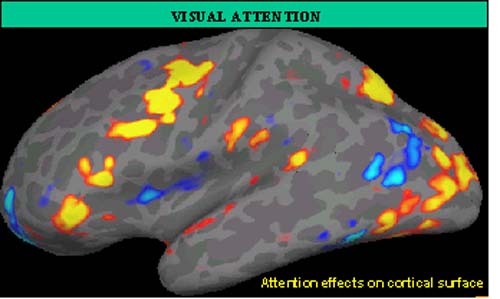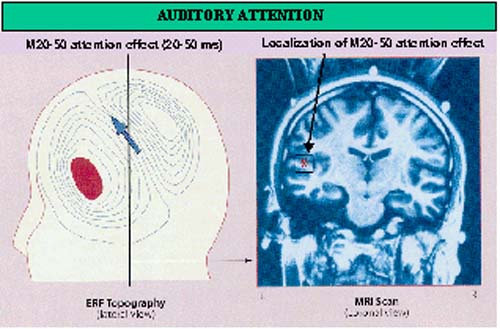The research in the Woldorff Lab at Duke is aimed toward the elucidation of the neural and psychological mechanisms underlying human perception and cognition, with particularly strong interests in the mechanisms of auditory and visual attention and perception. To study these phenomena we use various brain imaging techniques, principally event-related potentials (ERPs) and functional MRI (fMRI), along with concomitant recording of behavioral measures. We also have ongoing international collaborations with laboratories employing whole-head magnetoencephalography (MEG).
 Our general view is that each of the brain imaging methodologies provides an important but incomplete measure of brain function and activity, and that the most powerful approach is the combined application of several of them. Attention effects on cortical surface For example, hemodynamic (i.e., blood-change based) measures of brain activity (e.g., fMRI) are very good at showing which areas of the brain are activated under one sort of a task versus another, or even by one sort of event type vs. another, but they generally provide temporal information only on the order of seconds. Since many perceptual, attentional, and cognitive brain operations occur on the order of tens or hundreds of milliseconds, fMRI (at least in its typical present form) provides relatively little information on the time course or sequence of the functional brain activations underlying such operations.
Our general view is that each of the brain imaging methodologies provides an important but incomplete measure of brain function and activity, and that the most powerful approach is the combined application of several of them. Attention effects on cortical surface For example, hemodynamic (i.e., blood-change based) measures of brain activity (e.g., fMRI) are very good at showing which areas of the brain are activated under one sort of a task versus another, or even by one sort of event type vs. another, but they generally provide temporal information only on the order of seconds. Since many perceptual, attentional, and cognitive brain operations occur on the order of tens or hundreds of milliseconds, fMRI (at least in its typical present form) provides relatively little information on the time course or sequence of the functional brain activations underlying such operations.
 ERPs and MEG, on the other hand, although they have substantially coarser spatial resolution, provide a millisecond-by-millisecond reflection of evoked brain activity, thereby providing high resolution timing information. In addition, anatomical MRI provides extremely high-resolution images of the neuroanatomical structures of the brain. Thus, combining these approaches holds the promise of revealing not only which neuroanatomical structures are activated during various mental functions, but also what the time course and sequence of these activations are. Such 4-D spatial / temporal information is critical to develop full-fledged neural and cognitive models of brain function. The combination of these different measures of brain function is pursued both on the basis of independent measures of electrophysiological and hemodynamic activity and, recently, by integrating information from EEG and fMRI that has been recorded simultaneously. The study of attentional, perceptual, and other cognitive processes using such a combined multi-methodological approach is the major aim of our research.
ERPs and MEG, on the other hand, although they have substantially coarser spatial resolution, provide a millisecond-by-millisecond reflection of evoked brain activity, thereby providing high resolution timing information. In addition, anatomical MRI provides extremely high-resolution images of the neuroanatomical structures of the brain. Thus, combining these approaches holds the promise of revealing not only which neuroanatomical structures are activated during various mental functions, but also what the time course and sequence of these activations are. Such 4-D spatial / temporal information is critical to develop full-fledged neural and cognitive models of brain function. The combination of these different measures of brain function is pursued both on the basis of independent measures of electrophysiological and hemodynamic activity and, recently, by integrating information from EEG and fMRI that has been recorded simultaneously. The study of attentional, perceptual, and other cognitive processes using such a combined multi-methodological approach is the major aim of our research.
